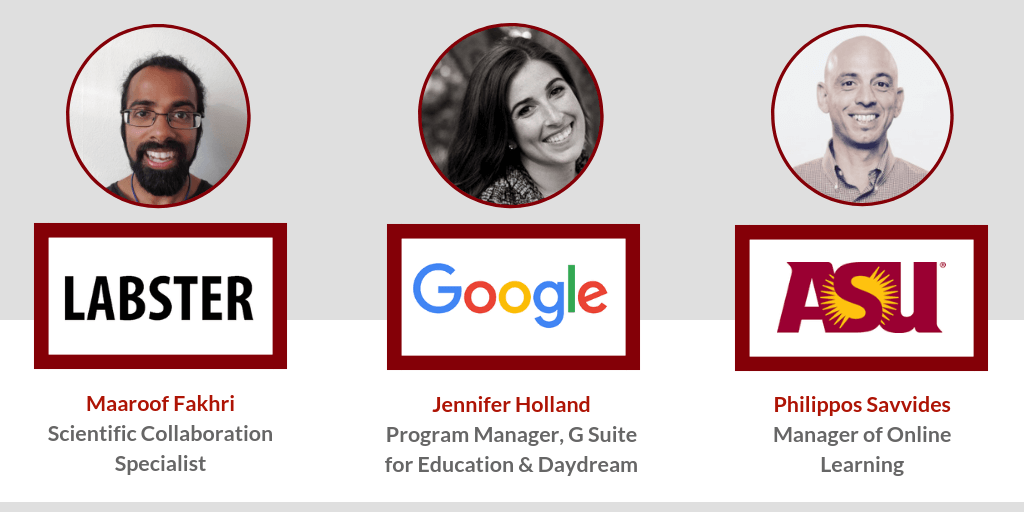REIMAGINE NEWSLETTER: ISSUE 30
A WELL-KEPT SECRET: HOW TO MAKE LEARNING GAMES WORK WONDERS IN THE CLASSROOM


Join Google, Labster and ASU at Reimagine Education 2018 for a panel discussion on bringing science education online. Find out how the first fully online biology degree with VR was created, learn about the importance of this revolutionary education model, and discover how such a project can be carried out effectively.
About Reimagine Education
The Oscars’ of Education, Reimagine Education Conference and Awards, is right around the corner. On November 29-30, you can join all those seeking to shape the future of education in an international competition rewarding innovative initiatives aimed at enhancing student learning outcomes & employability.
This year, over 1150 educational innovators from all the world submitted their projects to 17 award categories, and we are very excited to announce that Labster has been shortlisted for the VR/AR category!
Aside from the Reimagine Education Awards ceremony, Labster will also be participating in a few other activities, for which we invite you to join. These include a panel discussion with ASU, Google and Labster, and a workshop on online science courses.
Read on to learn more about the panel discussion and visit this page for more information and to sign up for a Labster demo for a chance to win a VR headset!
Join the panel discussion to learn about Labster VR and the Google and ASU partnership
Earlier this year, Google, Labster and ASU partnered on a revolutionary project to bring a full biology degree online for the first time via VR. This partnership set out to address the need for change in STEM education that has long been underway.
Already in February 2012, Former President Obama’s Council of Advisors on Science and Technology released a report stating that the nation needs one million new STEM workers by 2022 in order to meet future demands.
On top of this, three years later, a Nature article described in a study of 17,000 students across the US that 60% of STEM students were leaving STEM before graduation.
These problems can be addressed in two primary ways: First, by giving more students the opportunity to take a STEM degree, and second, by keeping them enrolled by, for example; motivating them, improving the teaching methods and helping them graduate by providing flexible study options.
How Labster VR is a part of the solution
Labster VR offers students access to a realistic lab experience that gives them the opportunity to practice and master different skills and techniques they are taught in class. In a virtual lab they can perform experiments and practice their skills in a engaging, exciting and risk-free learning environment.
By unlocking the physical lab requirements using virtual reality, students are given the opportunity to participate in lab experiences on campus or remotely. This gives students who may not have access to a lab, due to for example their geographical location, the opportunity to take a STEM degree.
For students who do have access to a lab, virtual labs also bring great opportunities. Students can for example experiment with advanced equipment that either is too expensive for the institution to purchase, or that requires special training to use. Labster’s virtual labs can even provide experiences impossible to give students, like travelling to another planet to study unique ecosystems.
From the students’ perspective, virtual labs can offer a safe environment where they can try, fail, learn and gain confidence before they enter a real lab.
This is all due to the advanced technology that Labster offers that has been proven to engage and motivate students, and to enhance their learning.
The Labster VR experience
Virtual labs offer students a true-to-life lab experience that brings together many elements that, combined, make the students feel like they are in a real lab environment.
Students can interact with lab equipment, perform experiments, make mistakes and discover solutions to problems (with some guidance from Dr One, an in-lab digital assistant). They work through real-life case stories, some of which are difficult or impossible to do in a face-to-face course, and get feedback all along the way through quiz questions and hypothesis testing.
Students can also explore the molecular world, observing gene expression, or look inside the machines they are operating to discover what is happening after they turn it on, and why the results look the way they do.
Students are not limited by ordinary time restraints and safety concerns, and because they work in the lab as individuals, they receive personalized feedback, giving each student the opportunity to learn at their own pace, and in their own way.
Why VR?
A commonly asked question for Labster is: Why use high-immersion VR technology, and not just stick to desktop lab simulations? Is Labster introducing VR technology for the technology’s sake? Isn’t VR more a hype than a help?
The answer is that VR, in the advanced version that we have today, brings something to the table that desktop simulations do not.
The first prototype of Labster VR came out several years ago, and has since then gone through testing and development in order to create the much-improved technology that Labster VR is today. In addition, Labster has taken a research-oriented approach and learned about the effects and impact of the technology, allowing for its continuous development and improvement.
Labster VR builds upon the success of 2D simulations, but allows for an experience that closely replicates the in-person experience. With its high immersion technology, it truly makes the learner feel like they are there.
A key finding from the research so far has been that immersive VR is significantly better for skills transfer than the equivalent low-immersion computer simulation or reading (study under review).
ASU and the first online biology degree
Before deploying the VR technology into ASU’s online biology degree, which was the first online BSc biology degree to be launched in the world this fall, Labster tested the content and the new hardware with almost 100 students, and used the feedback to improve the VR user experience and the content delivery.
Some of the main findings were that the majority of the students thought the content was useful for learning and that they really felt like they were in a real lab. This was an important finding as a realistic experience can help create a sense of confidence for the students.
The majority of the students also found it easier to learn with VR, which again was considered a significant finding considering it is still a new technology that most have no experience using.
A successful start with Google and ASU
Labster VR has overall received a very positive welcoming since the first courses with Labster VR rolled out this fall.
There is already huge demand and uptake for the degree program with the students, and ASU has declared this their fastest growing program so far.
We know that the majority of the uptakers of ASU Online degrees are students returning after leaving college earlier in life, who are coming back to complete their degrees. This just goes to show how effective online degrees are in getting students to complete their degrees, and how it is thereby contributing to solving one of the major problems in STEM education today.
Many of the uptakers are also students with full time jobs, meaning these degrees open up opportunities for these people, as graduating would simply not be possible, if they were not able to learn on their own time.
Join the panel discussion to learn more about online degrees
Having achieved great success with their partnership, this panel, featuring Labster, Google and ASU, will share their insights into how VR can enable new online degrees, giving students all over the world access to science education.
JOIN THE DISCUSSION ON NOVEMBER 29, 1:30 PM-2:10 PM AT TRACK 1 AT THE REIMAGINE EDUCATION CONFERENCE. SIGN UP FOR A LABSTER DEMO AT THE CONFERENCE TODAY AND GET THE CHANCE TO WIN A VR HEADSET.

